Epsom salt– scientifically called magnesium sulfate, has been known for its usage in horticulture. Especially the growth of tomato plants. This mineral compound is popular for its ability to correct magnesium deficiencies in the soil which promotes robust and healthy tomato plant growth. This article will discuss how Epsom salts can be used practically by gardeners when growing their vegetables. This elaborate manual aims at equipping you with knowledge on how to increase tomato harvests and improve the quality of your fruits using Epsom salt. This informative piece explains how magnesium sulfate works and how it affects plant physiology and gives step-by-step directions relevant to advanced and beginner farmers who want to use this useful farming method.
What Are the Benefits of Epsom Salt for Tomato Plants?
To begin with, Epsom salt has multiple uses for tomato plants due to its high magnesium content. Photosynthesis in which it acts as the central atom of the chlorophyll molecule is why magnesium is crucial. Chlorophyll production is promoted by adding magnesium through Epsom salt, resulting in green and healthy foliage. Moreover, sulfur in Epsom salt plays a major role in synthesizing important proteins and amino acids. This double action considerably enhances vegetative growth and improves mineral uptake while making the plants more resistant to other stress factors. Thus, application of Epsom salts can lead to increased fruit setting, bigger tomatoes, as well as more vibrant and tasty produce. Regular applications also help alleviate common problems like yellowing leaves or stunted growth thus ensuring successful tomato crop.
How Does Epsom Salt Help with Magnesium Deficiency?
Magnesium deficiency on tomato plants manifests as interveinal chlorosis where veins remain green while spots between them turn yellow. Since it contains magnesium sulfate that provides instantly available magnesium ions, this happens because it is made up of readily accessible magnesium sulfate ions. The addition helps to promote optimal chlorophyll production thereby curing chlorosis and returning the plant’s color back to its normal greenness. Given that this element plays a fundamental role in enzyme activity and energy transfer within plant cells, restoration will guarantee continuous growth together with enhanced photosynthetic efficiency and better resistance against stressing conditions.
Can Epsom Salt Improve Fruit Production?
Epsom salt can indeed improve fruit production in tomato plants if used properly. This essential mineral element supplies tomato plants what they need for photosynthesis, protein synthesis among other physiological processes required for survival by any living organism including humans. This enhancement improves nutrient assimilation into plant tissues, leading to a higher flower set, larger fruit’ weight as well and improved taste. Thus if regular applications are followed then disorders like lack of enough magnesium shall be solved and therefore the plants shall continue growing strongly resulting in high yield of tomatoes.
What Role Does Sulfur Play in Plant Growth?
Sulfur is an essential nutrient for plant growth, as it produces proteins and chlorophyll. For example, sulfur is one of the basic constituents of proteins as it forms amino acids such as cysteine and methionine. Also, sulfur comprises component vitamins and coenzymes involved in different biosynthetic processes. Ideally, between 0.2% – 0.5% dry matter basis of sulfur is required for healthy development of plants. In addition, it also participates in nitrogen metabolism of a plant as well as synthesis of essential oils and aromatic compounds that determine smell or taste of the crop produced. Therefore, adequate availability ensures better resistance to diseases, improved growth rates and higher quality produce hence necessary for good plant health.
When and How to Add Epsom Salt to Tomato Plants?
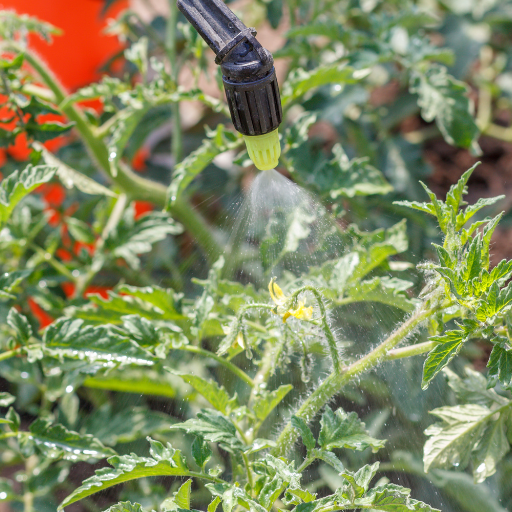
Tomato plants can be enhanced with Epsom salt in its planting, throughout the growing season and after the first fruits have formed. Mix a tablespoon of Epsom salt with the soil in the hole where you are planting. Two table spoons of Epsom salt should be dissolved in a gallon of water for every 2 to 4 weeks during the growing period and used as a solution to water plants. After fruit set, foliar application can be beneficial; dissolve a tablespoon of Epsom salt in a gallon of water and spray the plant leaves every two weeks. Regularly applying these nutrients ensures that plants receive an adequate amount of magnesium and sulfur which increasing their nutrient uptake and overall health.
Should You Add Epsom Salt During Planting?
Adding Epsom salts while planting tomato plants can bring numerous benefits mainly because it is made up of magnesium sulfate. Magnesium helps in photosynthesis while sulfur assists in amino acid production. Suggests that adding Epsom salts into planting holes can aid nutrient absorption as well as prevent common deficiencies. In this context, one tablespoon of Epsom salts added to the hole where tomatoes are planted will effectively address these issues by enabling even distribution within the root zone. Importantly, this parameter guarantees sufficient initial magnesium and sulfur availability so important for robust early growth that sets up conditions favorable for healthier productive plants. This practice may prevent yellowing leaves or late flowering declining signs associated with magnesium deficiency.
How to Apply Epsom Salt as a Foliar Spray?
First, dissolve one tablespoonful spoonfulofEpson salt in one gallon of water before spraying it as foliage. For proper dissolution, mix it thoroughly into homogeneous mixture ensuring that all particles melt completely inside it. And finally transfer your concoction into any clean container ready for use through spraying onto vegetation’s leaves but not drenching them up to runoff. The best time for applications of foliar is either early in the morning or late in the evening in order to avoid sunburns on leaves.
- Concentration: One tablespoon of Epsom salt per gallon of water. This ratio ensures sufficient magnesium and sulfur without causing potential salt stress to the plants.
- Frequency: Apply every two weeks. Regular intervals help maintain consistent magnesium and sulfur levels in the plants, optimizing nutrient uptake.
- Time of application: Early morning or late evening. This timing reduces the risk of phototoxicity due to sun exposure on wet leaves and allows for better absorption of the nutrients.
How Often Should Epsom Salt Be Applied?
Regarding plant health, Epsom salts should be used twice weekly. It means that your plants will always have adequate supplies of these minerals because they are essential for various processes like production chlorophyll and nutrient uptake. Overuse can lead to imbalances and even stress a plant so strict adherence must be paid to biweekly periodization. Thus, frequent checks on plants’ response to treatment may call for altering the number of times this substance is applied if there are any cases with an excessive or insufficient presence thereof inside organisms.
How Much Epsom Salt to Use for Tomato Plants?
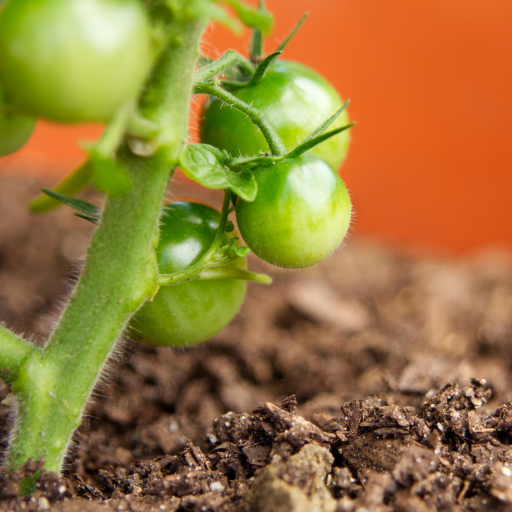
It is recommended that tomato plants use one tablespoon of Epsom salt for every foot of plant height. This supplies the right amount of magnesium and sulfur, essential nutrients required for healthy growth, blooming as well as fruiting. Add this amount to your water at least once every two weeks to avoid shortages leading to yellow leaves or meager fruiting. The Epsom salt should be dissolved in water completely in order to facilitate uniform distribution and efficient intake by the tomato plants’ root systems.
How can I Dilute Epsom Salt for Garden Use?
Diluting Epsom salt for garden use is generally advised to be in the ratio of one tablespoon of Epsom salts per gallon. This makes a solution suitable for many types and varieties providing them with enough magnesium and sulfur they need. For foliar applications, it is good practice to use a fine mist sprayer that will ensure even coverage without causing runoff on the leaves.
For root drenching, a similar concentration also applies—one tablespoon of Epsom salt per gallon of water. In this case, pour the mixture straight onto the soil near the base of the plant so that it can reach down into the roots where it can be absorbed directly by them.This is why applying early morning or late evening enhances evaporation reduction thereby improving nutrient uptake.
Periodic soil testing should be done to determine nutrient levels and subsequently adjust either the concentration or frequency of applying Epsom salts; otherwise, overuse may lead to nutrient imbalances and salt build-up in soils, thus negatively affecting plant health. Therefore, always start with the recommended dilution and then adjust depending on how plants are responding and the status of soil conditions.
What’s One Plant Recommended Dosage?
The addition rate depends on type and size of a plant hence different rates apply; tomato plants among other vegetables would take approximately one tablespoon per each gallon of water which has been mixed with Epsom salts for soil drench or foliar spray applications every two weeks. Consequently, flowering plants and shrubs may find one teaspoon per gallon of water that is applied monthly as more appropriate. It is always important to watch the plant reaction and adjust the level of application accordingly so as to prevent over-application and ensure good soil health.
Can You Put Too Much Epsom Salt?
Too much Epsom salt can cause magnesium buildup into the soil reducing calcium and potassium uptake by other essential elements. This nutrient imbalance can cause deficiency symptoms in plants lowering their growth potential hence reducing overall plant health. On the other hand, over-application will lead to an increased soil salinity which could damage plant root function and soil structure. The possibility of this happening can be avoided through adherence to prescribed doses besides regular monitoring of soil nutrients levels.
What Are the Signs That Your Tomato Plants Need Epsom Salt?
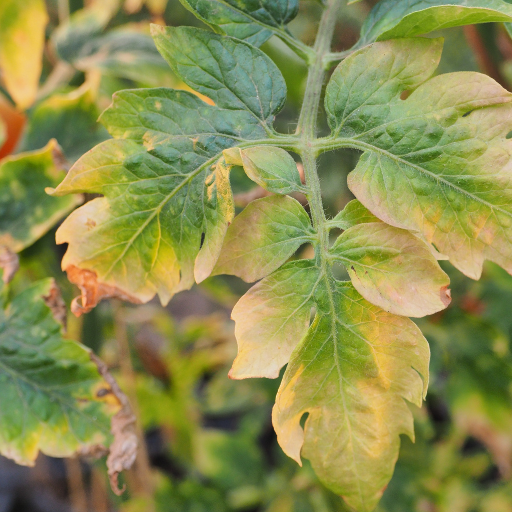
One of the major signs that your tomato plants may need Epsom salt is yellowing leaves, with yellowed areas occurring between veins while the veins remain green. This condition known as interveinal chlorosis suggests a lack of magnesium. Lack of magnesium might be responsible for slow-growing or low-yielding tomato plants. On top of that, blossom end rot has some darkened dents in the fruits’ tips due to nutrient imbalance where adding magnesium through Epsom salts might help. These symptoms and signs should therefore be monitored for the administration of Epsom salt.
How to find out if you lack Magnesium?
To establish whether or not your tomatoes have enough magnesium, several things have to be taken into account. One needs to check for interveinal chlorosis on the leaves which involves areas outside veins becoming yellow whereas the green coloration remains within them . This is mostly seen on older leaves first. Additionally, leaves will curl up and become wrinkled as they develop purple or brown spots.
Small tomatoes with less flavor and stunted growth are other indicators of a magnesium deficiency (Ferreira et al., 2013). It also leads old leaves falling off prematurely. Therefore, it is necessary to keep watching these signals closely by doing a soil test to confirm that this really is a case of insufficient amounts of magnesium in the soil (Reichman et al., 2012). Soil tests help accurately measure magnesium levels such that any changes made in nutrient regime are based on reliable data. For optimum plant health and productivity, one should maintain optimal levels ranging from 100 ppm to 200 ppm (parts per million) of Mg.
What Are Some Signs Of Blossom End Rot?
Several distinct features about this disease can aid its identification: initially, small water-soaked spots appear at the bottom side of the fruit, then these spots increase rapidly and darken, usually turning brown or black. As the condition progresses, it becomes leathery or sunken in appearance. This problem is most common in large-fruited types that are grown rapidly and mostly affects the first fruits of the season.
The major cause of blossom end rot is calcium deficiency which can occur even when soil calcium levels are adequate. In this case, irregular water supply may also lead to poor calcium uptake by the plant. Additionally, excessive nitrogen application promotes rapid vegetative growth hence causing blossom end rot to tomato plants (Lichter, 2016). Finally saline soils interfere with calcium absorption due to their high salinity levels. Avoiding fluctuating soil moisture will prevent blossom end rot and ensure proper amounts of calcium while fertilizers with a lot of nitrogen should be avoided.
The optimum calcium level in soil should be between 1,000 ppm and 3,000 ppm (parts per million) for a healthy, productive tomato crop (Tindal et al., 2014). Therefore, regular testing for soil properties has to be done to ascertain that Ca falls within these parametric bounds, thus enhancing the healthiness and productivity trends of tomatoes.
Does Epsom Salt Require a Soil Test Before Use?
To ascertain the need for application, it is highly recommended that a soil test be carried out. In other words, through the soil tests one can determine the current levels of magnesium and sulfur which are the main components of Epsom salt. Using Epsom salt without proper research on the land can lead to nutrient imbalance which may be more harmful rather than beneficial. It could also result in high levels of magnesium if overused and these would affect uptake of other vital nutrients such as potassium and calcium among others. Thus, carrying out a soil test helps ensure that any alterations are grounded on empirical evidence leading to optimum plant health and productivity.
Can Epsom Salt be Used with Other Fertilizers and Nutrients?
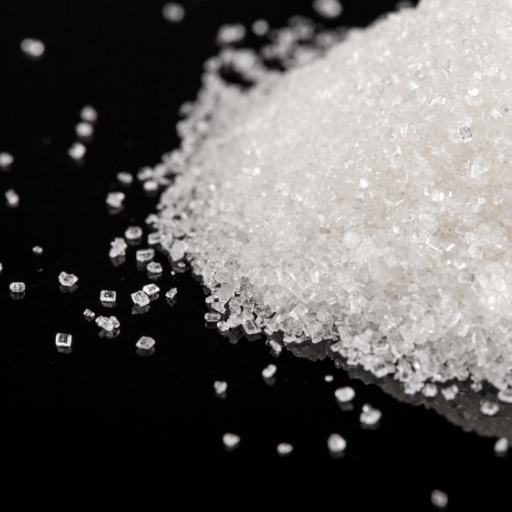
Yellow leaves between veins and green veins should be a big warning sign that your tomato plants need to be given some Epsom salt. This is a condition where the plant is deficient in magnesium and it is called interveinal chlorosis. Additionally, when tomato plants grow slowly or produce less fruit you will know that they have insufficient magnesium as an underlying cause. Another case of this disease may lead to dark sunken spots on the end of the fruits while there might also be nutrient imbalance where magnesium supplementation through Epsom salt could be helpful.
How to Identify Magnesium Deficiency?
Several signs point out the presence of magnesium deficiency in tomato plants. First, look at leaves for interveinal chlorosis, where leaf tissues between veins turn yellow but veins remain green. This is usually seen first on older leaves. Another sign that can suggest Mg deficiency includes curling or wrinkling of leaves and purple or brown spots.
For growth, we often observe stunted growth and reduced yield in plants lacking Mg with smaller tomatoes that are less tasty than usual. The oldest leaves may also fall off prematurely. Watch carefully for these symptoms and conduct soil testing to confirm Mg deficiency. It’s important that soil tests for accurate measurement of magnesium level so as to ensure any changes curried into profiles are based on reliable information about crops’ nutrition status. The desirable magnitude range to maintain plant healthiness and productivity lies between 100-200 ppm (parts per million).
What Are the Symptoms of Blossom End Rot?
The characteristic features associated with blossom end rot make it easy to identify this disorder. Initially, small watery patches may appear on the lower side of the fruit. Within a short period, these patches enlarge, turning mostly brown or blackish in coloration. Furthermore, the advanced stage shows a leather-like or sunk look in the affected area. Moreover, it affects early fruits and is more often found in large-fruited varieties grown where they develop very fast.
Blossom end rot is mainly caused by calcium deficiency which could be there in spite of sufficient soil calcium. As a result of irregular water supply, plants may not take as much calcium as needed, which causes this imbalance. Other factors contributing to blossom end rot include excessive nitrogen fertilization which increases vegetative growth too fast, and saline soils that inhibit calcium uptake. To avoid such diseases, maintain constant soil moisture, ensure appropriate amounts of calcium and do not overuse fertilizers rich in nitrogen.
The maximum permissible level of calcium in soils should be within one thousand to three thousand parts per million (ppm). A consistent soil test can help determine whether there are enough calcium levels since low levels might hinder tomato plant development and productivity.
Are Soil Test Required Before Using Epsom Salt?
A soil test is strongly advised to ensure you use the proper amounts of Epsom salt. The levels of magnesium and sulphur in the soil, which are the key ingredients found in Epsom salt, can be determined by conducting a soil test. Nutritional imbalances can be caused if Epsom salt is applied without first testing the soil properly. Overuse will create a situation where there is too much magnesium in the soil, which will interfere with other essential minerals such as calcium and potassium. Therefore, doing a soil test becomes necessary to ensure that any additions are based on experimental data so that an optimal plant productivity can be enhanced.
Are There Any Risks in Using Epsom Salt?
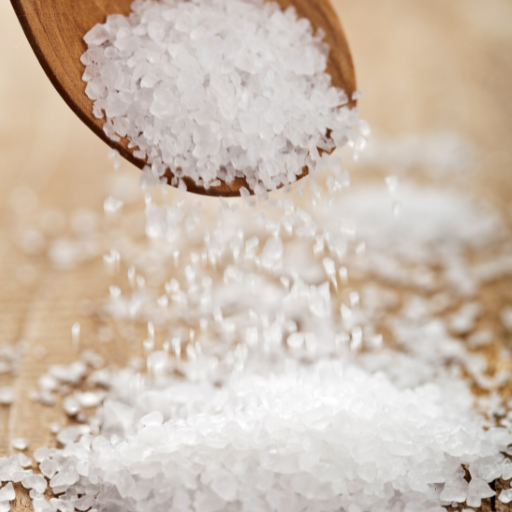
Epsom salt has benefits to plants but there are dangers of using it. The soil can accumulate a lot of magnesium due to excessive use of Epsom salts inhibiting other essential elements such as potassium and calcium thereby the imbalances in the soil leading to plant’s nutrient deficiencies and consequently stunting their growth/ Additionally, surplus magnesium changes the soil pH level, texture and availability of solvable nutrients that are considered important for all organisms. It is therefore vital that recommended instructions be followed while taking into account soil analysis so that rates of application are managed correctly hence no adverse impacts on plant health.
Possible Side Effects on Soil Composition
Several side effects can occur when Epsom salt is added to soils, disrupting both composition and healthiness. One problem that might arise is an accumulation of magnesium sulfate in the ground, which affects its structure, hence nonporousness, as well as bad drainage. Eventually, with time, this may lead to compaction, which will limit water supply to roots, hence poor root development.
Another concern involves modifying soil pH levels where magnesium sulfate is introduced; this process tends to make some elements like phosphorus less available. Evidence indicates that most crops receive optimal nutrition under certain pH conditions, usually around 6-7 on the pH scale. Deviations from this range can affect nutrient up take by plants.
Furthermore, high concentrations of magnesium compete with and suppress other essential minerals including calcium and potassium required for structural integrity/cell walls plus enzyme working within them respectively. Empirical findings indicate 50% reduction in Ca2+ and K+ uptake when excess Mg2+ was applied thus disturbing various life processes e.g photosynthesis crucial for energy production.
Therefore, routine soil assessments focusing on factors such as Mg concentration, soil structure and pH readings need be carried out regularly if any negative impacts on both land fertility or crop viability are to be minimized as concerns application patterns/quantities made possible through this type of approach, which depends on data.
Risks of Over-Application
Over-applying Epsom salts has several harmful consequences for plant growth and soil quality. First, surplus magnesium sulfate can cause nutrient imbalances that affect plants’ intake of calcium and potassium. This affects roots’ ability to take in water and nutrients and can result in yellowing leaves (chlorosis). Studies have shown that high magnesium levels reduce potassium and calcium uptake by up to 50%, thus disrupting the plants’ biological activities.
Secondly, excessive use of Epsom salts can modify soil physical properties. High levels of magnesium sulfate accumulation result in soil compaction which reduces porosity hindering root penetration as well as water mobility. Lack of air movement and poor drainage creates an environment where root decay spreads quickly due to anaerobic conditions leading to disease development.
Further still, continuous usage may cause great changes in the pH of soils again. The optimum pH for most crops ranges from about 6.0 – 7.0, but with some, due to excess Mg content, their acidity increases, hence reducing the availability of fundamental nutrients like phosphorus. This leads to more complexity in plant nutrition hence growth deficiency also transpires here too;
To avoid these unwanted consequences, it is extremely important to follow recommended Epsom salt dosages and test soil regularly. The main parameters of interest are magnesium concentration (targeting levels within 50-200 ppm), soil structure, and pH, which should all be kept in the optimal range for the specific crop. Soil tests need to be carried out during at least one growing season to enable the exact and beneficial use of Epsom salts and protect both soil health and plant life.
Is Epsom Salt Safe for All Types of Plants?
However, not every kind of plant can safely tolerate Epsom salts even though they may provide essential minerals like magnesium and sulfur to some plants. Some species may already have abundant amounts of magnesium in their soils; therefore adding more could result in nutritional imbalances. Additionally, while such crops as tomatoes or peppers might respond well to Epsom salt treatment during deficiencies, others, such as low-magnesium ones, may get nothing from it. Consequently, a proper assessment of individual plant requirements and pre-treatment (applying Epsom Salts) analysis of soil conditions is essential in ensuring no negative effects on plants’ health when using this compound.
Frequently Asked Questions (FAQs)
Q: Why should I use Epsom salt for plants, especially tomatoes?
A: Epsom salt is beneficial for growing tomatoes because it provides essential micronutrients like magnesium and sulfur. These nutrients help improve seed germination, enhance nutrient absorption, and lead to healthier, more productive plants.
Q: How do I apply Epsom salts to the soil when planting tomatoes?
A: At the initial planting stage, you can add 1 tablespoon of Epsom salts into the planting hole and mix it with the soil. This helps ensure that the plants have a good starting supply of magnesium and sulfur.
Q: How often should I add Epsom salts in water for my tomato plants?
A: It’s recommended to dissolve 1 tablespoon of Epsom salts in a gallon of water and apply this solution once every two to four weeks. This ensures that the plants get a consistent supply of magnesium and sulfur throughout their growing season.
Q: How does magnesium benefit the tomato plants?
A: Magnesium is critical for seed germination and plays a significant role in photosynthesis, which helps plants produce the energy they need to grow. A deficiency in magnesium or sulfur can lead to reduced growth and poor harvests.
Q: Can using too much Epsom salt harm my tomato plants?
A: Yes, using too much Epsom salt can lead to an excess of magnesium, which could interfere with the plant’s ability to absorb other essential nutrients like calcium and potassium. Always adhere to recommended amounts to avoid nutrient imbalances.
Q: Are there any signs that my tomato plants need Epsom salt?
A: Plants may show signs like yellowing between the veins of older leaves, reduced growth, or poor fruit production if there is a deficiency in magnesium or sulfur. If your plants look like they are struggling, consider using Epsom salts.
Q: How does Epsom salt affect pest control in a vegetable garden?
A: While Epsom salt is not a pesticide, healthy plants are generally more resistant to pests. By ensuring your tomato plants have adequate magnesium and sulfur, you can improve their overall health and resilience against pests.
Q: Can I use Epsom salts for other plants in my vegetable garden, like pepper plants?
A: Yes, Epsom salts are good for most vegetable plants, including pepper plants, as they provide essential micronutrients that support overall plant health and productivity. Apply similarly as you would for tomatoes.
Q: How do I incorporate Epsom salts for seed starting?
A: For seed starting, you can mix 1 tablespoon of Epsom salts into the soil mix to ensure that seedlings receive adequate micronutrients right from the beginning. It helps in better seed germination and stronger initial growth.






